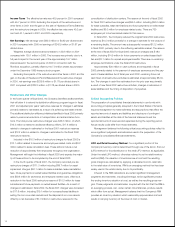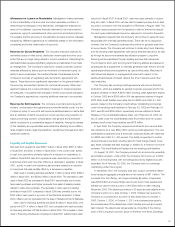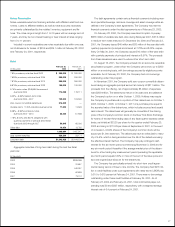Albertsons 2002 Annual Report Download - page 26
Download and view the complete annual report
Please find page 26 of the 2002 Albertsons annual report below. You can navigate through the pages in the report by either clicking on the pages listed below, or by using the keyword search tool below to find specific information within the annual report.
Summary of Significant Accounting Policies
Principles of Consolidation The consolidated financial statements
include the accounts of the Company and its subsidiaries. All significant
intercompany accounts and transactions have been eliminated.
Revenue and Income Recognition Revenues and income from product
sales are recognized at the point of sale for retail food and upon shipment of
the product for food distribution. Revenues and income from services ren-
dered are recognized immediately after such services have been provided.
Allowances for Losses on Receivables Management makes estimates
of the uncollectibility of its accounts and notes receivable portfolios. In
determining the adequacy of its allowances, management analyzes the
value of the collateral, customer financial statements, historical collection
experience, aging of receivables and other economic and industry factors.
It is possible that the accuracy of the estimation process could be materi-
ally impacted by different judgments as to collectibility based on the infor-
mation considered and further deterioration of accounts.
Reserves for Closed Properties The Company maintains reserves for
estimated losses on retail stores, distribution warehouses and other proper-
ties that are no longer being utilized in current operations. Calculating the
estimated losses requires significant judgments and estimates to be made
by management. The Company’s reserves for closed properties could be
materially affected by factors such as the extent of interested buyers, its
ability to secure subleases, the creditworthiness of sublessees and the
Company’s success at negotiating early termination agreements with
lessors. These factors are significantly dependent on the general health of
the economy and resultant demand for commercial property. While man-
agement believes the current estimates of reserves on closed properties
are adequate, it is possible that changes in events could cause changes in
the Company’s assumptions, requiring additional reserves to be recorded.
LIFO and Retail Inventory Method Inventories are stated at the lower
of cost or market. Cost is determined through use of the last-in, first-out
(LIFO) method for food distribution or the retail LIFO method, as applicable.
Under the retail LIFO method, otherwise referred to as the retail inventory
method (RIM), the valuation of inventories are at cost and the resulting
gross margins are calculated by applying a calculated cost-to-retail ratio to
the retail value of inventories. The Company utilizes LIFO or the retail LIFO
method to value approximately 69.8 percent and 75.5 percent of the
Company’s consolidated inventories for fiscal 2002 and 2001, respectively.
The first-in, first-out method (FIFO) is used to determine cost for some of
the remaining highly consumable inventories. Market is replacement value.
If the FIFO method had been used to determine cost of inventories for
which the LIFO method is used, the Company’s inventories would have
been higher by approximately $140.8 million at February 23, 2002 and
$140.6 million at February 24, 2001.
Notes to Consolidated Financial Statements
Reserves for Self Insurance The company is primarily self-insured for
workers’ compensation and general and automobile liability costs. It is the
Company’s policy to record its self insurance liabilities based on claims filed
and an estimate of claims incurred but not yet reported. Any projection of
losses concerning workers’ compensation and general and automobile
liability is subject to a considerable degree of variability. Among the causes
of the variability are unpredictable external factors affecting future inflation
rates, litigation trends, legal interpretations, benefit level changes and claim
settlement patterns.
Property, Plant and Equipment Property, plant and equipment are car-
ried at cost. Depreciation, as well as amortization of assets under capital
leases, are based on the estimated useful lives of the assets using the
straight-line method. Estimated useful lives generally are 10 to 40 years for
buildings and major improvements, 3 to 10 years for equipment, and the
shorter of the term of the lease or expected life for leasehold improvements.
Interest on property under construction of $5.7, $8.1 and $4.8 million was
capitalized in fiscal years 2002, 2001 and 2000, respectively.
Goodwill and Other Intangible Assets Under existing accounting rules,
goodwill and other intangible assets are amortized on a straight-line basis
over an estimated useful life, or if no useful life is determinable, over a period
no greater than 40 years. Through fiscal 2002, the recoverability of goodwill
is assessed by determining whether the goodwill balance can be recovered
through projected undiscounted cash flows and operating results over its
remaining life. Impairment of the asset would be recognized when it is prob-
able that such future undiscounted cash flows will be less than the carrying
value of the asset. Goodwill is shown net of accumulated amortization of
$218.5 million and $171.3 million in fiscal 2002 and 2001, respectively.
In fiscal 2003, SFAS No. 142, “Goodwill and Other Intangible Assets”
will become effective for the Company and as a result, the Company will
cease to amortize goodwill and other intangibles deemed to have indefinite
lives. In lieu of amortization, the Company is required to perform an initial
impairment review of its goodwill and other intangibles in fiscal 2003 and
an annual impairment review thereafter. The Company expects to complete
its initial review prior to the end of the first quarter of fiscal 2003. Other
intangible assets with determinable lives will continue to be amortized over
their respective useful lives and will also be subject to annual impairment
testing based on estimated fair value.
Retirement Plans The Company sponsors pension and other retirement
plans in various forms covering substantially all employees who meet eligibil-
ity requirements. The determination of the obligation and expense for these
plans is dependent on management’s selection of certain assumptions used
by actuaries in calculating such amounts. Those assumptions are described
in the Retirement Plans footnote to the consolidated financial statements
and include the discount rate, expected long-term rate of return on plan
assets, and rates of increases in compensation and healthcare costs. The
24
























